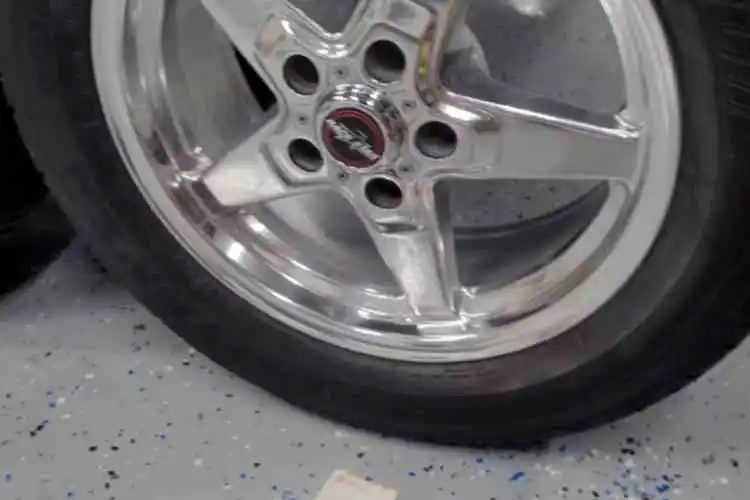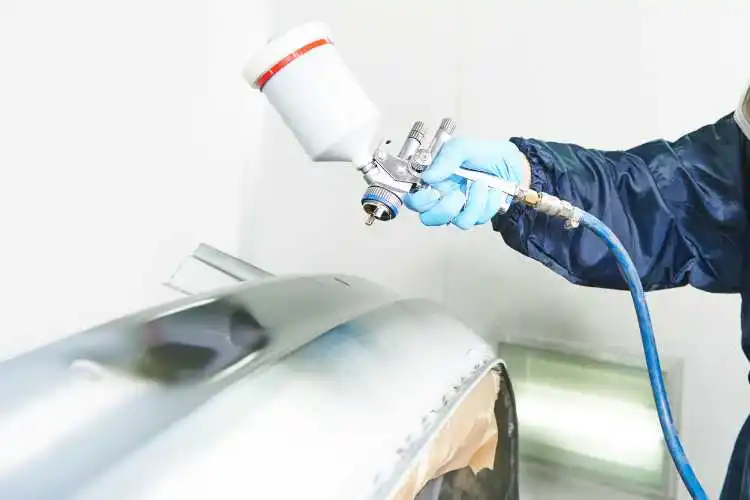Can You Vinyl Wrap Over Primer?
If you’re planning to give your car a new look, vinyl wrapping is a great option. It’s a cost-effective way to change the color and style of your car without having to get a new paint job.
So, Can You Vinyl Wrap Over Primer? Vinyl wrapping over primer is feasible given proper surface preparation. Well-cured and compatible primer provides an adhesive-friendly base for vinyl adhesion.
Texture and cleanliness are vital for success. Primer enhances initial grip, but thorough testing and professional guidance ensure a durable and attractive vinyl wrap.
What is Primer?
Before we dive into whether you can vinyl wrap over primer, let’s talk about what primer is. A primer is a type of paint that is applied to a surface before the topcoat.
It’s designed to provide a smooth and even surface for the topcoat to adhere to. Primer also helps to protect the surface from rust and other types of damage.
Can You Vinyl Wrap Over Primer?
The short answer is yes, you can vinyl wrap over primer. In fact, it’s recommended that you apply primer to your car before you vinyl wrap it.
This is because primer provides a smooth and even surface for the vinyl wrap to adhere to. Without primer, the vinyl wrap may not stick properly and could peel off over time.
Is It Possible to Vinyl Wrap Over Primer?
Vinyl wrapping over primer is feasible, albeit with caution. Primer provides a preparatory surface for paint or other coatings, enhancing adhesion and promoting an even finish.
Applying vinyl wrap onto properly cured and well-prepared primer can be successful, as long as the primer is smooth, free of contaminants, and adheres firmly to the substrate.
However, factors such as primer type, compatibility with vinyl adhesive, and the specific vinyl material should be considered.
Thorough surface cleaning and ensuring the primer’s integrity are crucial to prevent adhesion issues.
Consulting with professionals and conducting small-scale tests are advisable before proceeding with a full vinyl wrap-over primer.
Does Primer Attract Water?
Primer exhibits varied hydrophilic properties depending on its composition. Generally, water-based primers tend to attract and absorb moisture due to their porous nature.
Oil-based primers, on the other hand, display reduced water affinity due to their hydrophobic nature. The level of water attraction is contingent upon the primer’s formulation and porosity.
Additionally, environmental conditions and exposure duration can influence water absorption. Precautions such as proper sealing and regular maintenance are advisable to mitigate potential water-related effects on primed surfaces.
Will Vinyl Wrap Stick Easily over Primer than Paint?
Vinyl wrap adherence to primer versus paint hinges upon several factors. Primer, being a preparatory coating, offers a porous and adhesive-friendly surface, often promoting better initial adhesion compared to smooth paint finishes.
However, the primer’s formulation and compatibility with vinyl adhesive play pivotal roles. Paint, particularly glossy or slick types, might pose challenges due to reduced surface texture.
Achieving successful vinyl adhesion on both substrates necessitates meticulous surface preparation, ensuring cleanliness, texture optimization, and compatibility testing to ascertain durable and long-lasting results.
Is Primer a Good Foundation for Vinyl Wrap?
Utilizing primer as a foundation for vinyl wrap can be advantageous when certain conditions are met.
Primer, designed to enhance adhesion and surface quality, can offer a conducive base for vinyl adhesion. Compatibility between the primer and vinyl adhesive is pivotal, as well as the primer’s texture and porosity.
A properly prepared and cured primer can provide a stable and adhesive-friendly surface, promoting successful vinyl application.
Thorough surface cleaning, texture optimization, and primer-adhesive synergy are essential for achieving a durable and aesthetically pleasing vinyl wrap outcome.
Can I Wrap Immediately after Primer Has Been Applied?
Wrapping immediately after primer application is ill-advised. Primer requires ample time to cure and achieve optimal bonding properties.
Premature wrapping can hinder primer’s adhesion, potentially leading to vinyl detachment or uneven finish.
Awaiting the manufacturer-recommended curing period, typically 24 to 48 hours, ensures the primer’s stability and enhances the likelihood of successful vinyl adhesion.
Adhering to curing guidelines, combined with meticulous surface preparation, contributes to a durable and aesthetically pleasing vinyl wrap outcome.
How To Wrap Vinyl Over Primer?
Wrapping vinyl over primer demands a systematic approach. Firstly, ensure the primer is well-cured and the surface is clean and smooth.
Verify primer-vinyl compatibility. Employ proper tools for precise cutting and application. Heat assists conforming to contours.
Begin from an edge, gradually pressing vinyl onto the surface, smoothing out air bubbles.
Use heat to enhance adhesion. Exercise patience and precision to achieve a seamless and durable vinyl wrap over primer.
Does Vinyl Wrap Damage Primer?
Vinyl wrap typically does not damage properly cured primer when applied correctly. Primer serves as a preparatory layer for paint and coatings, enhancing adhesion.
Vinyl wraps adhere well to primer, and their removal rarely affects the primer beneath. However, improper installation or aggressive removal techniques might compromise the primer.
It is advisable to adhere to proper vinyl application methods and removal procedures to minimize potential damage to the primer beneath.
Can I Wrap Over Fillers?
Wrapping over fillers necessitates caution. Fillers, used to repair surface imperfections, have varying textures and adhesion properties.
A properly prepared and well-adhered filler might offer a suitable base for the vinyl wrap. However, irregularities or weakly bonded fillers can lead to vinyl detachment or uneven finish.
Thoroughly sanding, priming, and ensuring strong filler-substrate adhesion are crucial. Conducting tests on small areas and consulting professionals aids in determining the compatibility of fillers with vinyl wrapping for optimal results.
Will Vinyl Wrap Protect Primer?
Vinyl wrap can serve as a protective layer over primer, safeguarding it from minor abrasions, UV exposure, and environmental elements.
However, the extent of protection depends on the vinyl thickness and quality. Thicker, high-quality vinyl offers enhanced defense.
Regular maintenance and avoiding harsh conditions maintain the wrap’s protective role.
It’s essential to ensure proper vinyl application to prevent potential moisture or debris entrapment that might affect the primer over time.
What are the Worst Paint Conditions for Vinyl Wrap?
Vinyl wrap encounters challenges with deteriorating or peeling paint, uneven surfaces, and non-adherent coatings.
Rough or corroded paint inhibits vinyl adhesion, resulting in an unsatisfactory finish. Cracked or chipped paint allows moisture infiltration, jeopardizing wrap longevity.
Applying vinyl over fresh or uncured paint leads to inadequate bonding. Furthermore, wrapping over repainted areas with poor preparation or incompatible paint risks premature lifting or bubbling.
Optimal results demand a smooth, clean, and well-adhered paint surface for successful vinyl application.
Tips for Vinyl Wrapping Over Primer
Now that you know you can vinyl wrap over primer, here are some tips to help you get the best results:
1. Make Sure the Primer is Dry
Before you start applying the vinyl wrap, make sure the primer is completely dry. If the primer is still wet, the vinyl wrap may not stick properly and could peel off over time.
Depending on the type of primer you use, it may take several hours or even a full day for the primer to dry completely.
2. Clean the Surface
Before you apply the vinyl wrap, make sure the surface is clean and free of debris. Use a microfiber cloth and some rubbing alcohol to clean the surface.
This will help the vinyl wrap adhere properly and prevent any dirt or debris from getting trapped under the vinyl.
3. Use a Heat Gun
When applying the vinyl wrap, use a heat gun to help it adhere properly.
The heat gun will help the vinyl wrap conform to the curves and contours of your car. Be careful not to overheat the vinyl wrap, as this could cause it to melt or shrink.
4. Take Your Time
Vinyl wrapping can be a time-consuming process, so make sure you have enough time set aside to complete the job.
Rushing the process could result in a poor-quality finish or even damage to your car. Plan ahead and give yourself plenty of time to complete the job properly.
5. Consider Hiring a Professional
If you’re not confident in your vinyl wrapping skills, or if you want a more professional-looking finish, consider hiring a professional to do the job for you.
A professional vinyl wrap installer will have the experience and tools necessary to get the job done right.
Conclusion
In conclusion, you can vinyl wrap over primer. In fact, it’s recommended that you apply primer to your car before you vinyl wrap it.
Just make sure the primer is dry, the surface is clean, and you take your time to get the best results.
If you’re not confident in your vinyl wrapping skills, consider hiring a professional to do the job for you. With these tips, you can give your car a new look with a vinyl wrap that will last for years to come.



